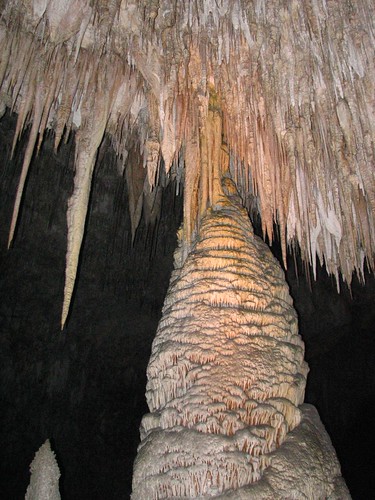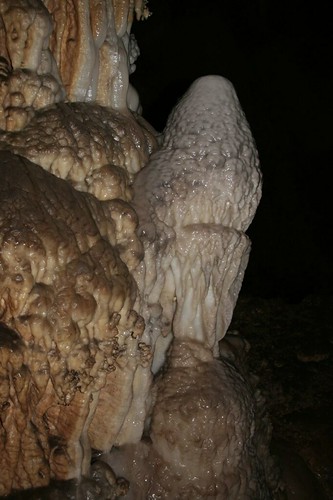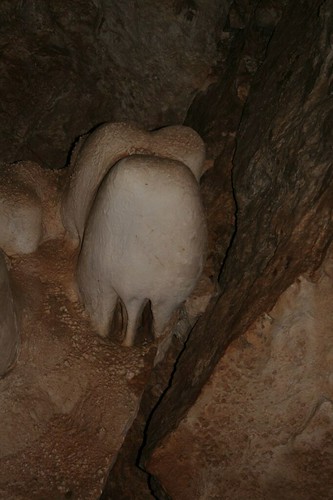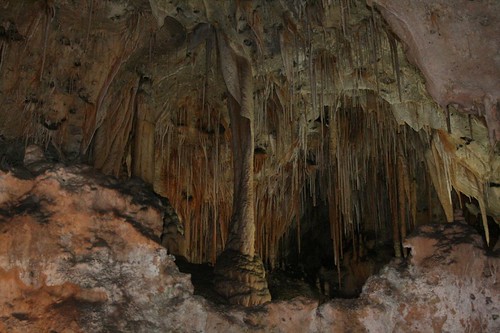The meeting point for the tour is an underground cafeteria/rest area, complete with snacks, restrooms, and souvenirs. As the tour started, someone asked why the ceiling in the area was all black. The ranger giving the tour responded that in the early days of the concession area, there was no elevator and all the food had to be carried in. Instead of carrying the trash back out, and up 750 feet to the cave entrance, they burned it. Since there isn’t a lot of air flow in the cave, burning the trash resulted in a noticeable amount of damage.
The cave was discovered in the late 1800s by a cowboy named Jim White who noticed what looked like smoke coming from the area. The “smoke” turned out to be bats exiting the cave in the evening. In the early days after the discovery of the cave, the cave was damaged by other activities that would never be allowed today. For example, they used to hold dances in the large rooms of the cave and people would pose for photos touching cave formations. As a result, in the central areas of the cave, the formations are not as nice as those at other caves. As you move away from the main rooms, there are more formations that are untouched.
Another interesting tidbit about the early days of the cave is that a huge number of bats made it their home. When the cave was discovered, it contained an enormous amount of guano. Someone filed a mining claim for the guano and proceeded to remove many tons of it from the cave for use as fertilizer. Who would have thought you could file a mining claim for guano?
The most striking thing about the cave at Carlsbad is that it’s huge. The rooms are much bigger than other caves we’ve been at, like Wind Cave and Jewel Cave in South Dakota. The Big Room is 1.5 miles around, the ceiling of the room was really, really high, and the formations were correspondingly large – the scale is just immense.
The tour that we took was the Kings Palace tour. It bypassed most of the Big Room in favor of four smaller, though still impressively sized, chambers. Along the way, we brushed up on our cave formation terminology and got some cool photos.
A column and stalactites:

More stalactites:


A stalagmite:

One of the only cave formations that we saw that is still growing (only about 5% of the cave formations are still active):

This interesting formation is known by the playful name “the bashful elephant”:

More intricate stalactites:


If all of the different cave formations names are too tough to remember, we learned a new word that covers them all – speleothem.
After the cave tour, we attended the evening bat program. The cave is home to a huge population of bats most of the year and they all exit the cave around dusk to feed for the night. There is an amphitheater at a natural opening of the cave and the program started at 5 pm. Apparently the bats are unpredictable. The poor ranger leading the program ended up with over an hour to fill before the bats emerged around 6:10. He did a good job of stalling, though, and after we learned more than we thought we’d ever know about bats, tens of thousands of them were suddenly spiraling out of the cave and into the sunset in large clusters. The bats spiral counterclockwise to gain height while exiting. They were generally heading off in one direction (away from us, thankfully), but every once in a while one or two bats would seem to get confused and then bats would end up swirling overhead for a few moments. This continued spiraling out of the cave for 15 minutes while we watched, sometimes seeming to taper off before starting again. When we left, bats were still streaming from the cave into the dusk. Unfortunately, we don’t have any photos because cameras were not permitted to avoid disturbing the bats. It was an amazing show – it was crazy to think that just a few weeks ago, the bats numbered in the hundreds of thousands, not just the tens of thousands we were seeing!
From Carlsbad, we drove to set up camp at the Pine Springs campground in Guadalupe Mountain National Park. Along the way, we tried in vain to find the Red Sox World Series game on the radio. Mostly we got static. Occasionally, the radio would pick up baseball and then it would quickly be overpowered by a Spanish station on the same frequency.
The campground was hopping – at least by our recent standards – but we still had several sites to choose from. Though it was only sevenish, it was well after dark, but setting up camp was easy in the full moon (which also happened to be the largest full moon of the year). It was also the warmest that it had been in a long time, so we dawdled over dinner and read for awhile before bed. The next day we were planning to do some hiking at the park.
2 comments:
I just watched the "Caves" episode of Planet Earth. It looked just like your pictures. I'm jealous. I watch it on TV, you guys live it :)
Next week we're planning to visit Mammoth Cave in Kentucky. Why don't you come with us? :)
It's hard to do justice to a cave in pictures. Maybe it's possible with a video -- I'd like to see the Planet Earth episode. But of course, we don't get TV around here. :)
Post a Comment